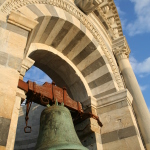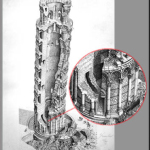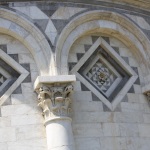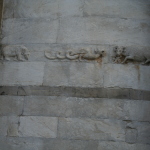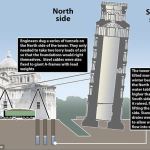The celebrated Leaning Tower of Pisa was intended to serve as the bell tower for the cathedral. Work began on 9 August 1173 (or 1174 according to the Pisan calendar of the period) and was completed in the middle of the 14th century.
The name of the architect is not known for certain. The project can probably be attributed to Diotisalvi, the same architect who designed the Baptistery of Pisa, and who must have worked in collaboration with the master builder Gerardo di Gerardo in the construction of the tower and with the sculptor Biduino in its decoration.
The tower owes its fame to the remarkable equilibrium in which it stands despite the fact that it is leaning at a distinct angle. This anomaly can be explained by the fact that the ground began to subside beneath the tower’s foundations during its construction. At the same time the tower has always been admired because it is one of the most complex and richly decorated exemplars of a medieval tower to have survived to the present day.
The tower, which stands about 56 meters high, was built of white marble and a gray stone quarried in the Monti Pisani and other hills lying north of the city. It owes its cylindrical form to its circular ground plan.
The base of the tower is decorated with a row of blind arches. Above it rise six orders of colonnaded loggias that are accessible via the tower’s winding staircase. At the summit is a belfry dating to the 14th century, which is also circular but smaller in diameter and therefore concentric to the tower. The belfry is pierced by six large arches supported by pilasters and above them six smaller arches with columns. The summit of the belfry has an ornate cornice and a walkway from which one can enjoy a vista of the cathedral square and the city of Pisa.
The tower began to lean at an angle due to the presence of a small watercourse running beneath its foundations. This caused the ground to subside and forced construction work on the tower to be interrupted around 1185 when the stonemasons were working on the third order of loggias. It was only resumed a century later under the supervision of the architect Giovanni di Simone, who completed the three successive orders of loggias, building them at an opposing angle to avoid any further inclination of the tower.
The belfry was built in two phases, the first around 1300, most probably under the direction of Giovanni Pisano, and the second in the middle of the 14th century by the atelier of the sons of Andrea Pisano – Nino and Tommaso Pisano.
The base of the tower is decorated with scenes of animals in combat that have been attributed to Biduino, to whom may also be ascribed the capital with intertwining monkeys on one of the columns in the ground level order of arches. The original capital is conserved in the Castle of Blienicke in Berlin and has been replaced by a copy.
The Leaning Tower underwent a complete restoration between 1990 and 2001, during which its angle of inclination was corrected slightly from 4.5° to 3.97° along the vertical axis. A system of sensors was added to monitor the state of the monument, and any movement can be compensated for by a system of stay rods and metal cables that are under constant traction. The marble cladding of the tower was restored and cleaned in a painstaking process that was completed in 2011.
The Leaning Tower is one of the most famous monuments in the world, a symbol of Italian art and culture, and a superb example of the Pisan Romanesque style of architecture.







